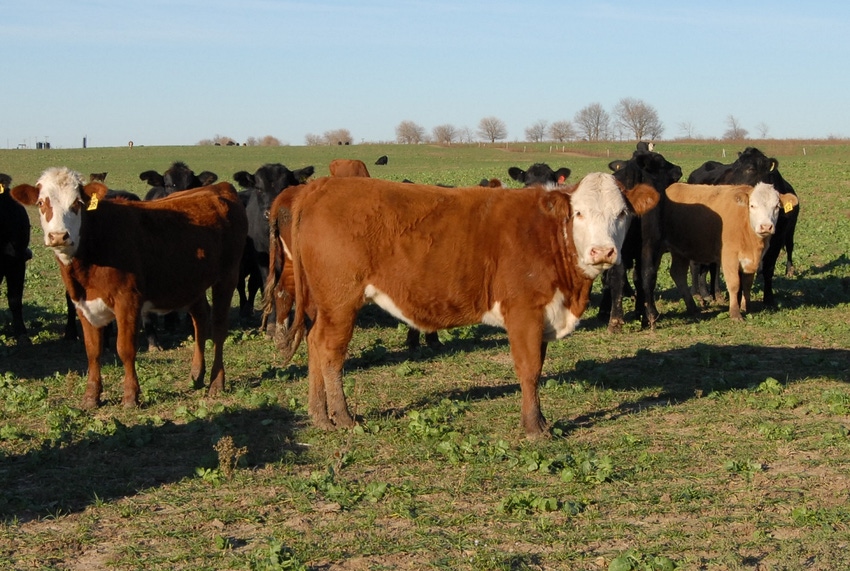
Cow prices have taken a beating the last few months, and I believe it's at least partly because we've lost so much equity in our cattle and there's not as much money available.
Now it's obvious some of the problem comes from us being at the "bottom" of the cattle cycle -- meaning we've about reached the point where everyone that wants a cow has a cow. Look at the cow slaughter numbers, for evidence.
But think about this for a financial problem: Wally Olson from Claremore has several times pointed out to me that we've seen cows go from $3,000-$3,500 in 2014 or so to $1,000 or less today. Truthfully, if you're looking for the right kind of cow, meaning she doesn't have to be big and black and fat, there are some pretty nice ones out there for $700 or so. But let's stick with the $1,000 figure for this example.
That's a drop of maybe $2,000 or more per cow. In the simplest of terms, considering USDA said in July of this year there were just under 32 million beef cows in the national inventory, how much money is that?
I'll save you the math: It's a $64 billion decline in value/equity.
If it was your own money that evaporated, that's like playing the stock market. If it's the banker's money, that's an entirely different pain.
I'm leading you with what I think is a small piece of a bigger problem.
I have lived through one major downturn in agriculture, and I fear we're seeing another one now. They're never quite the same, but it seems they all share some common threads, at least going back through the last century.
The 1980s and the agricultural economy of today both were preceded by, and likely partially caused by government-created booms.
The bust of the 1980s was at least partially set up by a combo of government subsidies, government trade booms and busts, the credit crunch and staggering interest rates, and the overall stress on the economy from the whole oil-embargo, oil-shortage, oil-price-hike conflagration.
That's the way I remember it.
The new one has some interesting success stories in exports, long reputed as the savior of American agriculture. But I think it's primary root system grew in the ethanol boom set up by government subsidies to oil companies (gasoline blenders, they were called). There are other factors at work, but the ethanol boom passed billions of former tax dollars through to the holders of land and the producers of corn and corn ethanol, inflating fundamentally everything they touched and further raising the cost of inputs, especially land which does not ratchet down in price with any rapidity but usually crashes.
As I said, there are other factors at work, such as foreign land ownership, real subsidies to some parts of the agricultural complex and not to others, and trillions of funny money pumped into the stock market so the people made rich by that have re-invested some of that wealth into various types of land, including agricultural land. But I digress.
So I grow increasingly worried about the overall condition of agriculture in this country.
Private economist Bill Helming, in his last-ever printed newsletter just days ago, shared these figures:
USDA says farm bankruptcies increased by 24% in September of this year. Helming noted these causative factors: Low grain prices, the US trade war with China and Europe, and unfavorable weather and crop planting and growing conditions. He said USDA reported more than 19.4 million acres of farmland nationwide were not planted because of record spring rains and historic crop field flooding.
Further, data from the US court system shows that for the 12-month period ending in September 2019, Chapter 12 farm bankruptcies were 580 filings, which was up 24% from the previous year and at the highest level since the year 2011.
Factored into this whole set of problems is a never-ending spiral of cost escalation on the farm and ranch. In fact I believe it is one of the fundamental problems.
And at the basest level, the soil is getting more and more damaged as a living entity, therefore cropping gets more difficult and requires more inputs, and grazing livestock get less of what they need from grazing. We can reverse all this by use of the growing knowledge about producing soil health through mixed-species cover cropping of cropground and adaptive, multi-paddock grazing with cattle and sheep on multi-species pastures and the aforementioned cover crops.
It will take more thought, some experimentation, and change of personal habitual behaviors, but there is not a person in the world who is incapable of learning new ways. We need only to make the choices to learn. The alternative playing out before us seems bleak.
About the Author(s)
You May Also Like




